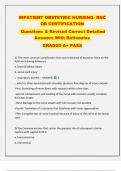INPATIENT OBSTETRIC NURSING- RNC
OB CERTIFICATION
Questions & Revised Correct Detailed
Answers With Rationales
GRADED A+ PASS
1) The most common complication that occurs because of excessive force on the
fetal neck during delivery is
a. brachial plexus injury
b. spinal cord injury
c. respiratory distress - ANSWER A
...which is often associated with shoulder dystocia. Five degrees of injury include:
-First: Stretching of nerve fibers with recovery within a few days
-Second: Compression and swelling of the nerve with recovery usually complete
but takes longer
-Third: Damage to the nerve sheath with full recovery not possible
-Fourth: Formation of a neuroma that interferes with never regeneration
-Fifth: Complete loss of nerve function because of injury of the nerve at the spinal
cord
2) The Cesarean incision that carries the greatest risk of subsequent uterine
rupture with vaginal birth is
a. low transverse
b. low vertical
,c. midline vertical (classic) - ANSWER C
Only patients with low transverse incisions, the most common type of incision
currently done, are considered for vaginal birth after Cesarean (VBAC). Risk
factors that preclude VBAC include small pelvis, previous Cesarean for prolonged
labor, previous uterine rupture, and obstetric complications (such as placenta
previa). A physician and anesthesiologist/anesthetist must be on site and
available in case emergency Cesarean is required.
3) The three classic signs of placental separation after delivery are
a. uterus falls, blood gushes, and cord lengthens
b. uterus rises, blood gushes, and cord lengthens
c. uterus rises, blood gushes, and cord shortens - ANSWER B
Extrusion of the placenta usually occurs within 30 minutes of delivery. Slight
tension is usually placed on the cord during delivery of the placenta, but excessive
tension may result in tearing of the cord or inversion of the uterus and must be
avoided. The placenta should be carefully examined after delivery to determine if
it is complete as placental fragments increase risk of maternal hemorrhage.
5) For a multipara, protracted labor is diagnosed when descent of the presenting
part is less than
a. 1 cm per hour
b. 2 cm per hour
c. 3 cm per hour - ANSWER B
For nullipara, protracted labor is less than 1 cm per hour. Other abnormal labor
patterns include prolonged latent phase when there is no progress from the
latent to the active phase after more than 20 hours for multiparas and more than
14 hours for nulliparas and arrest disorders, including secondary arrest of dilation
and arrest of descent.
,6) In a neonate with poor ventilation, the blood gas findings that indicate
respiratory acidosis are
a. decreased pH, increased base (pHCO3), and pCO2 and pO2 within normal limits
b. increased pH, decreased pCO2, increased pO2, and base within normal limits
c. decreased pH, increased pCO2, and pO2 and base within normal limits -
ANSWER C
....decreased pH (< 7.25), increased pCO2 (> 40 mmHg) and pO2 and base
(pHCO3) within normal limits.
Metabolic acidosis is indicated by decreased pH, increased base (pHCO3), and
pCO2 and pO2 within normal limits.
Respiratory alkalosis is indicated by increased pH, decreased pCO2, increased
pO2, and base within normal limits
Metabolic alkalosis is indicated by increased pH and base and pCO2 and pO2
within normal limits.
7) The Montevideo units needed for normal progress of labor are at least
a. 100
b. 150
c. 200 - ANSWER C
The MVUs are calculated by multiplying the number of contractions during a 10
minute period times the average intensity, above baseline, of the contractions. To
be effective, a contraction must generate at least 25 mmHg of peak pressure
, although 50-60 mmHg is considered optimal. Additionally, for labor to be
effective, at least 3 contractions are needed in a 10 minute period.
8) On the New Ballard Score for assessment of gestational age, a score of zero (0)
indicates how many weeks gestation?
a. 20
b. 24
c. 40 - ANSWER B
...the gestational age at which a fetus is considered viable. Scores range from -10
(20 weeks) to 50 (44 weeks) with each increase of 5 points on a scale indicating 2
additional weeks of gestation, so a score of +5 is equal to 26 weeks. The New
Ballard Score assesses 6 measures of neuromuscular maturity (posture, square
window, arm recoil, popliteal angle, scarf sign, and heel to ear). and 6 measures
of physical maturity (skin, lanugo, plantar surface, breast, eye/ear, genitals-male
and female).
9) Compound presentation of the fetus increases the risk of
a. umbilical cord prolapse
b. uterine rupture
c. hemorrhage - ANSWER A
...with about 15-20% of compound presentations requiring Cesarean delivery
because of prolapsed cord. With compound presentation (a rare event), one ore
more limbs, usually a hand or arm) prolapses along with the presenting part
(usually the cephalic vertex). If the extremity does not retract spontaneously or
cannot be retracted manually, Cesarean is usually required. Compound
presentation is more likely to occur with assisted obstetrics (amniotomy) and
preterm labor.





